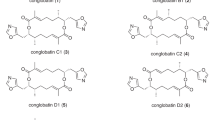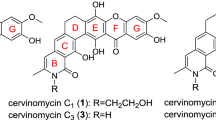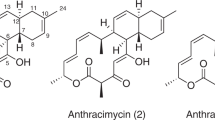Abstract
In this study, screening by LC–MS and cytotoxicity-guided isolation led to the identification of ulleungamide C (1), a previously unknown pipecolic acid-rich branched cyclic depsipeptide, from a soil actinobacterium Streptomyces sp. KCB13F003. The structure of 1 was determined by interpretation of spectroscopic and spectrometric data from 1D and 2D NMR and HRESIMS experiments. Antiproliferative assays using mammalian cancerous cells revealed that 1 inhibits the proliferation of HL-60 human promyelocytic leukemia cells. Cell cycle analysis showed an increased accumulation of cells in the G0/G1 phase after treatment with 1. Results of immunoblotting assays revealed that 1 reduced the expression levels of cyclin-dependent kinase 4 (CDK4), CDK6, retinoblastoma protein (Rb), and phosphorylated Rb, whereas it induced cyclin-dependent kinase inhibitor 1B (p27/Kip1) expression.
This is a preview of subscription content, access via your institution
Access options
Subscribe to this journal
Receive 12 print issues and online access
$259.00 per year
only $21.58 per issue
Buy this article
- Purchase on Springer Link
- Instant access to full article PDF
Prices may be subject to local taxes which are calculated during checkout




Similar content being viewed by others
References
Winn M, Fyans JK, Zhuo Y, Micklefield J. Recent advances in engineering nonribosomal peptide assembly lines. Nat Prod Rep. 2016;33:317–47.
Ying H, et al. Expanding metabolic pathway for de novo biosynthesis of the chiral pharmaceutical intermediate L-pipecolic acid in Escherichia coli. Microb Cell Fact. 2017;16:52.
Matson JA, Bush JA. Sandramycin, a novel antitumor antibiotic produced by a Nocardioides sp. Production, isolation, characterization and biological properties. J Antibiot. 1989;42:1763–7.
Lee KK, Gloer JB, Scott JA, Malloch D. Petriellin A: a novel antifungal depsipeptide from the coprophilous fungus Petriella sordida. J Org Chem. 1995;60:5384–5.
Coello L, Reyes F, Martín MJ, Cuevas C, Fernandez R. Isolation and structures of pipecolidepsins A and B, cytotoxic cyclic depsipeptides from the Madagascan sponge Homophymia lamellose. J Nat Prod. 2014;77:298–303.
Son S, et al. Ulleungamides A and B, modified α,β-dehydropipecolic acid containing cyclic depsipeptides from Streptomyces sp. KCB13F003. Org Lett. 2015;17:4046–9.
Liu G, Chater KF, Chandra G, Niu G, Tan H. Molecular regulation of antibiotic biosynthesis in Streptomyces. Microbiol Mol Biol Rev. 2013;77:112–43.
Radhakrishnan V, Song YS, Thiruvengadam D. Romidepsin (depsipeptide) induced cell cycle arrest, apoptosis and histone hyperacetylation in lung carcinoma cells (A549) are associated with increase in p21 and hypophosphorylated retinoblastoma proteins expression. Biomed Pharmacother. 2008;62:85–93.
Kitagaki J, Shi G, Miyauchi S, Murakami S, Yang Y. Cyclic depsipeptides as potential cancer therapeutics. Anticancer Drug. 2015;26:259–71.
Klisovic MI, et al. Depsipeptide (FR 901228) promotes histone acetylation, gene transcription, apoptosis and its activity is enhanced by DNA methyltransferase inhibitors in AML1/ETO-positive leukemic cells. Leukemia. 2003;17:350–8.
Rajgolikar G, Chan KK, Wang HC. Effects of a novel antitumor depsipeptide, FR901228, on human breast cancer cells. Breast Cancer Res Treat. 1998;51:29–38.
Goel S, DeCristo MJ, McAllister SS, Zhao JJ. CDK4/6 inhibition in cancer: beyond cell cycle arrest. Trends Cell Biol. 2018;28:911–25.
Giacinti C, Giordano A. RB and cell cycle progression. Oncogene. 2006;25:5220–7.
Plesca D, Mazumder S, Almasan A. DNA damage response and apoptosis. Methods Enzymol. 2008;446:107–22.
Soldani C, Scovassi AI. Poly(ADP-ribose) polymerase-1 cleavage during apoptosis: an update. Apoptosis. 2002;7:321–8.
Sharma A, Singh K, Almasan A. Histone H2AX phosphorylation: a marker for DNA damage. Methods Mol Biol. 2012;920:613–26.
Ahn J, Urist M, Prives C. The Chk2 protein kinase. DNA Repair. 2004;3:1039–47.
Acknowledgements
We thank Harumi Aono, Kai Yamamoto, Dr. Junnosuke Otaka, and Dr. Yushi Futamura in RIKEN Center for Sustainable Research Science for preliminary bioactivity tests. We also thank Dr. Shunji Takahashi in RIKEN for his helpful discussion about the ulleungamide family. This work was supported by the KRIBB Research Initiative Program and the R&D Convergence Program (CAP-16-03-KRIBB) of the National Research Council of Science and Technology (NST) funded by the Ministry of Science ICT (MIST) of the Republic of Korea. We thank the KBSI, Ochang, Korea, for providing the NMR and HRESIMS data.
Author information
Authors and Affiliations
Corresponding authors
Ethics declarations
Conflict of interest
The authors declare that they have no conflict of interest.
Additional information
Publisher’s note Springer Nature remains neutral with regard to jurisdictional claims in published maps and institutional affiliations.
Supplementary information
Rights and permissions
About this article
Cite this article
Son, S., Jang, M., Lee, B. et al. A pipecolic acid-rich branched cyclic depsipeptide ulleungamide C from a Streptomyces species induces G0/G1 cell cycle arrest in promyelocytic leukemia cells. J Antibiot 74, 181–189 (2021). https://doi.org/10.1038/s41429-020-00385-z
Received:
Revised:
Accepted:
Published:
Issue Date:
DOI: https://doi.org/10.1038/s41429-020-00385-z
This article is cited by
-
Precursor-directed biosynthesis and biological activity of tripropeptin Cpip, a new tripropeptin C analog containing pipecolic acid
The Journal of Antibiotics (2024)



